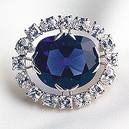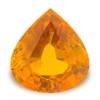Hope Diamond,

Hope diamond is a large 45.52 carats (9.10 g) deep blue diamond dwelled at the Smithsonian natural history museum in Washington. The stone was classified as a Type IIb diamond.
- Weight: 45.52 carats, (9.10 g)
- Clarity - VS1, Whitish graining is present
- Color - fancy deep grayish blue
- Cut - Cushion antique brilliant with faceted girdle and extra facets on the pavilion
- Country of origin – India
The history for the name of the stone began when the French merchant traveler Jean Baptiste Tavernier purchased a 112 3/16 carat diamond. The stone originated from Kollur mine in Golconda India. The gem was in some shape and crudely cut and color was illustrated by Tavernier as a “beautiful violet”.
Tavernier sold the diamond to King Louis XIV of France in 1668 and in 1673 the hope diamond was re-cut by Sieur Pitau, the court jeweler, weighing in a 67 1/8-carat. The color was described as an intense steely-blue and the gem was popularly known as the ""Blue Diamond of the Crown,"" or the ""French Blue”.
In September 1792, the French blue diamond was stone. In 1812, the deep blue diamond weighing 44.25 carat was predicted that its being in possession of London diamond merchant Daniel Eliason. Afterwards, at the death of King George IV of England in 1830, the blue diamond was sold through private channels due to his debts. Following the death of Henry Philip Hope in 1839, the diamond passed to his nephew Henry Thomas Hope and his grandson Lord Francis Hope. In 1902 Lord Francis Hope obtained permission from the Court of Chancery to sell the stone to pay off his debts. Then, it was sold to a London dealer and he sold to Joseph Frankels and Sons of New York City. Next, the diamond was sold to Selim Habib. In 1912, the diamond mounted as headpiece on three tierced circlets of large white diamonds. Sometimes later, the hope diamond became the pendant on diamond necklace as we know today. Mrs. McLean possessed her ownership until her death in 1947.
Harry Winston of New York purchased Mrs. McLean's entire jewelry collection including the Hope diamond, the 94.8-carat Star of the East diamond, the 15-carat Star of the South diamond, a 9-carat green diamond, and a 31-carat diamond that is now called the McLean diamond. For 10 years the stone was exhibited at many exhibits and charitable events world wide.
On November 10, 1958, Harry Winston donated the Hope diamond to the Smithsonian Institution. In 1962 it was exhibited for a month at the Louvre in Paris and in 1965 the Hope diamond traveled to South Africa where it was displayed at Rand Easter Show in Johannesburg. In 1984 the diamond was lent to Harry Winston as part of the firm's 50th anniversary celebration. In 1996 the Hope diamond was again sent to Harry for cleaning and some minor restoration work.
For many years, hope was reported to be 44.5 carats and in 1974, the diamond was removed from its setting and weighed the actual weigh as 45.52 carats. The hope diamond pendant is surrounded by 16 white diamonds, both pear and cushion cuts.
In December 1988, a team from GIA visited Smithsonian to grade the great blue stone as per present day techniques. They described the color as fancy dark grayish blue and in 1996 after another examination, they described the color as fancy deep grayish-blue.
NOVEMBER BIRTHSTONE - CITRINE

COMMEMORATIVE EVENT - 13th Anniversary
KEYWORDS - Success, Abundance, Personal Power
ALSO KNOWN AS - Merchant's stone, Success stone
COLORS - Pale yellow to brown
OCCURRENCE - Brazil
COLOR ZONING - Tiger stripes or Zebra stripes


